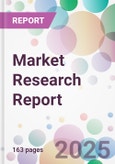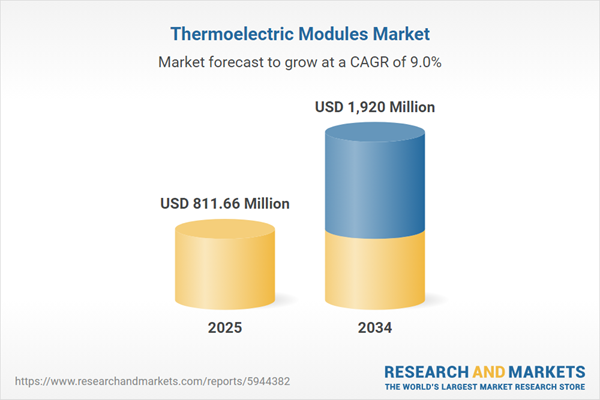Thermoelectric Modules Market Growth
Thermoelectric modules consist of highly doped semiconductor components with electrical carriers. These components are arranged in arrays, which are attached thermally in parallel and linked electrically in series. With the increasing technological advancements and rapid development of the healthcare industry, the demand for thermoelectric modules has increased, thus, aiding the growth of the thermoelectric modules market.The increasing use of thermoelectric cooling modules in medical and laboratory applications such as vaccine storage, air conditioning, medical facilities, food preservation, and electronic device cooling is the major factor driving the growth of the industry.
Thermoelectric Modules Market Trends
Thermoelectric modules are increasingly used to convert waste heat into electricity, enhancing energy efficiency in industries such as automotive and manufacturing. This capability supports efforts to reduce energy consumption and carbon emissions, which can impact thermoelectric modules market dynamics and trends.Ongoing research is leading to the development of advanced thermoelectric materials, improving the efficiency and performance of TEMs. These advancements are expanding the range of applications for TEMs. In the automotive sector, TEMs are utilised for vehicle cooling, heating, and power generation by converting exhaust heat into usable electrical energy, thereby enhancing fuel efficiency. The growing adoption of electric and hybrid vehicles is further driving the demand for TEMs.
Recent Developments
Kyocera Corporation announced the launch of an advanced Peltier (thermoelectric) module featuring enhanced heat absorption capabilities. This latest module boasts a maximum heat absorption rate that is 21% greater than that of Kyocera's traditional offerings, resulting in significantly improved cooling efficiency that can fuel the thermoelectric modules market value. The Peltier modules from Kyocera are mainly utilised for regulating the temperature of automotive batteries and seats, and this enhancement in cooling performance is expected to positively impact the longevity of batteries.Industry Outlook
An Expanding Mining and Electronics Sector Contribute to the Market Growth.According to the Federal Ministry Republic of Austria, Finance, and International Organizing Committee for the World Mining Congresses, Asia dominates global mineral production, contributing 60.4% of total output in 2021, followed by North America (15.3%). As per the thermoelectric modules industry analysis, Oceania and Europe each account for around 6.8% of production. Latin America accounts for 5.5% of the production followed by Africa with 5.2%. In battery materials, Asia’s dominance is even more pronounced, particularly in graphite production, where it accounts for 76.3% of the global share.
Cobalt production is heavily concentrated in Africa, which holds 72.6% of the global share, while lithium production is led by Oceania, contributing 48.9%, with Latin America following at 36.1%. These trends are critical for the growth of the thermoelectric industry, which relies on stable and accessible supplies of materials like graphite, lithium, and cobalt. Thermoelectric modules, used for power generation and cooling applications, require high-purity materials to achieve efficiency and performance targets. Asia’s dominance in graphite and significant role in lithium production suggest that the region will continue to be a key supplier for thermoelectric module manufacturers.
According to 2024 data, China leads the global electronics market with a substantial 27.4% share, far surpassing the United States, which holds 7.9%. Japan follows with 6.3%, and South Korea comes in at 5.3%. Germany, Taiwan, and Singapore also have notable market shares, with 4.2%, 3.9%, and 2.5% respectively, that can increase the thermoelectric modules industry revenue. The Netherlands, Hong Kong, and Malaysia round out the top ten, each contributing less than 2.5% to the global market. This distribution is significant for the thermoelectric module market, as these countries are major producers and consumers of electronics, which are key applications for thermoelectric modules.
High Reliability and Durability, Versatile Applications, and Lightweight Nature of Thermoelectric Modules Support the Growth of the Market.
- Thermoelectric modules have no moving parts, making them highly reliable and durable with minimal maintenance requirements.
- These modules are used in a wide range of applications, from cooling electronic devices and automotive systems to power generation in remote locations, making them a versatile solution for various industries.
- Thermoelectric modules are compact and lightweight, allowing for easy integration into small or portable devices, such as consumer electronics and medical device sectors.
- Thermoelectric modules provide a green energy solution as they can convert waste heat into usable electricity, contributing to energy efficiency and reducing carbon footprints as well as thermoelectric modules market revenue.
- Compared to traditional cooling and power generation technologies, thermoelectric modules generally have lower efficiency, which limits their widespread adoption in high-power applications.
- The materials used in thermoelectric modules, such as bismuth telluride, can be expensive, leading to higher initial costs for systems using this technology.
- The performance of thermoelectric modules is highly dependent on temperature gradients, which can limit their effectiveness in environments with stable or low-temperature differences, impacting thermoelectric modules demand forecast.
- Economic downturns or fluctuations in key markets could reduce investment in new technologies, including thermoelectric modules, slowing market growth.
- Changes in regulations regarding the use of certain materials or environmental standards could impact the production and adoption of thermoelectric modules.
- The increasing focus on renewable energy sources and energy efficiency drives demand for thermoelectric modules in power generation.
- Ongoing research and development in advanced materials, such as nanomaterials, could significantly improve the efficiency and performance of thermoelectric modules, boosting the thermoelectric modules demand growth.
- The growing consumer electronics market presents significant opportunities for thermoelectric modules in applications like portable coolers, electronic device cooling, and wearable devices.
- Industries are increasingly looking for energy-efficient solutions to reduce costs and comply with environmental regulations, which could boost the adoption of thermoelectric modules.
Thermoelectric Modules Industry Segmentations
The thermoelectric module, also known as a thermoelectric cooler or Peltier cooler, is an electronic semiconductor-based device that operates as a small heat pump and transfers heat from one side of the device to the other. By generating temperature differentials, thermoelectric modules can either cool or warm an object immediately. The thermoelectric modules market can be segmented based on technology, type, end-use, components, and functionality.On the basis of its technology, the industry can be divided into:
- Single Stage
- Multi Stage
Based on its components, the industry can be divided into:
- Hardware
- Software and Services
Based on its type, the industry can be categorised as:
- Bulk Thermoelectric
- Micro Thermoelectric
- Thin Film Thermoelectric
On the basis of its functionality, the industry can be segmented into:
- Deep Cooling Modules
- General Purpose Modules
- Temperature Stabilization
- Power Generation
- Others
Based on its end-use, the industry can be segmented as:
- Automotive
- Consumer Electronics
- Aerospace and Defence
- Medical and Laboratories
- Telecommunications
- Industrial
- Oil, Gas, & Mining
- Others
Based on region, the industry can be segmented as:
- North America
- Europe
- Asia Pacific
- Latin America
- Middle East and Africa
Thermoelectric Modules Market Share
Software and Services segment is expected to grow at a CAGR of 9.2% in the forecast period. Advanced software solutions are enabling precise modeling and simulation of TEMs, leading to optimised performance and efficiency. This advancement is crucial for applications requiring exact temperature control, boosting the thermoelectric modules demand.The incorporation of Internet of Things (IoT) technologies allows for real-time monitoring and control of TEMs. This integration enhances system responsiveness and energy efficiency, particularly in industrial and consumer electronics applications.
Competitive Landscape
The report presents a detailed analysis of the following key players in the global thermoelectric modules market, looking into their capacity, competitive landscape, and latest developments like capacity expansions, plant turnarounds, and mergers and acquisitions:- Ferrotec Holding Corporation
- Laird PLC
- II-VI Incorporated
- TE Technology, Inc.
- TEC Microsystems GmbH
- Crystal Ltd.
- Kryotherm
- RMT Ltd
- Thermion Company
- Thermonamic Electronics (Jiangxi) Corp., Ltd.
- Kelk Ltd.
- Others
Thermoelectric Modules Market Regional Analysis
The Asia Pacific market is expected to account for a significant thermoelectric modules market share. The markets in India and China are expected to grow at a CAGR of 10.1% and 9.7% in the forecast period. The region's growth is propelled by the widespread use of thermoelectric cooler devices in the automotive industry and healthcare sector. Countries like China, Japan, and South Korea are leading in manufacturing and technological advancements, contributing to the market's expansion.The market growth in North Ameria is fuelled by the adoption of advanced technologies in automotive and manufacturing sectors. The increasing applications of thermoelectric coolers in various industries are driving market expansion. The market in Canada is expected to grow at a CAGR of 9.3% between 2025 and 2034.
Competitive Factors in the Global Thermoelectric Modules Market.
- Companies that invest in research and development to enhance the efficiency of thermoelectric modules have a significant competitive edge.
- Companies leading in material innovation can offer superior products that set them apart from competitors.
- Companies that integrate thermoelectric modules with IoT and smart technologies, enabling real-time monitoring and control and increasing demand of thermoelectric modules market.
- Market Players that can produce thermoelectric modules more cost-effectively through economies of scale or sourcing cheaper raw materials can offer competitive pricing.
- Companies with a strong global distribution network can access a broader customer base and respond more effectively to regional market demands.
- Strategic partnerships with OEMs, system integrators, or technology companies can enhance market reach and provide opportunities for co-development of innovative solutions.
- Companies with a reputation for producing reliable, long-lasting modules can command customer loyalty and repeat business.
- Offering comprehensive after-sales services, such as maintenance, upgrades, or warranty support, can differentiate a company in a crowded market.
- Companies that focus on reducing the environmental impact of their products, and energy-efficient production processes, can appeal to environmentally conscious customers.
- The price of thermoelectric modules is heavily influenced by the availability and cost of key materials like bismuth telluride and other rare-earth elements.
- Innovations in materials science that allow for the use of less expensive or more abundant materials could reduce the cost of thermoelectric modules, making them more competitive.
- Advances in production technology that increase yield or reduce waste can lower costs, making the modules more affordable and boosting thermoelectric modules market expansion.
- Manufacturers may benefit from economies of scale, reducing the per-unit cost and allowing for more competitive pricing.
- The presence of multiple manufacturers and new entrants in the thermoelectric module market can lead to price competition, which may drive prices down.
- Manufacturers offering differentiated products, such as modules with higher efficiency or additional features, may be able to command higher prices.
Table of Contents
Companies Mentioned
The key companies featured in this Thermoelectric Modules market report include:- Ferrotec Holding Corporation
- Laird PLC
- II-VI Incorporated
- TE Technology, Inc.
- TEC Microsystems GmbH
- Crystal Ltd.
- Kryotherm
- RMT Ltd
- Thermion Company
- Thermonamic Electronics (Jiangxi) Corp., Ltd.
- Kelk Ltd.
Table Information
| Report Attribute | Details |
|---|---|
| No. of Pages | 163 |
| Published | August 2025 |
| Forecast Period | 2025 - 2034 |
| Estimated Market Value ( USD | $ 811.66 Million |
| Forecasted Market Value ( USD | $ 1920 Million |
| Compound Annual Growth Rate | 9.0% |
| Regions Covered | Global |
| No. of Companies Mentioned | 12 |









